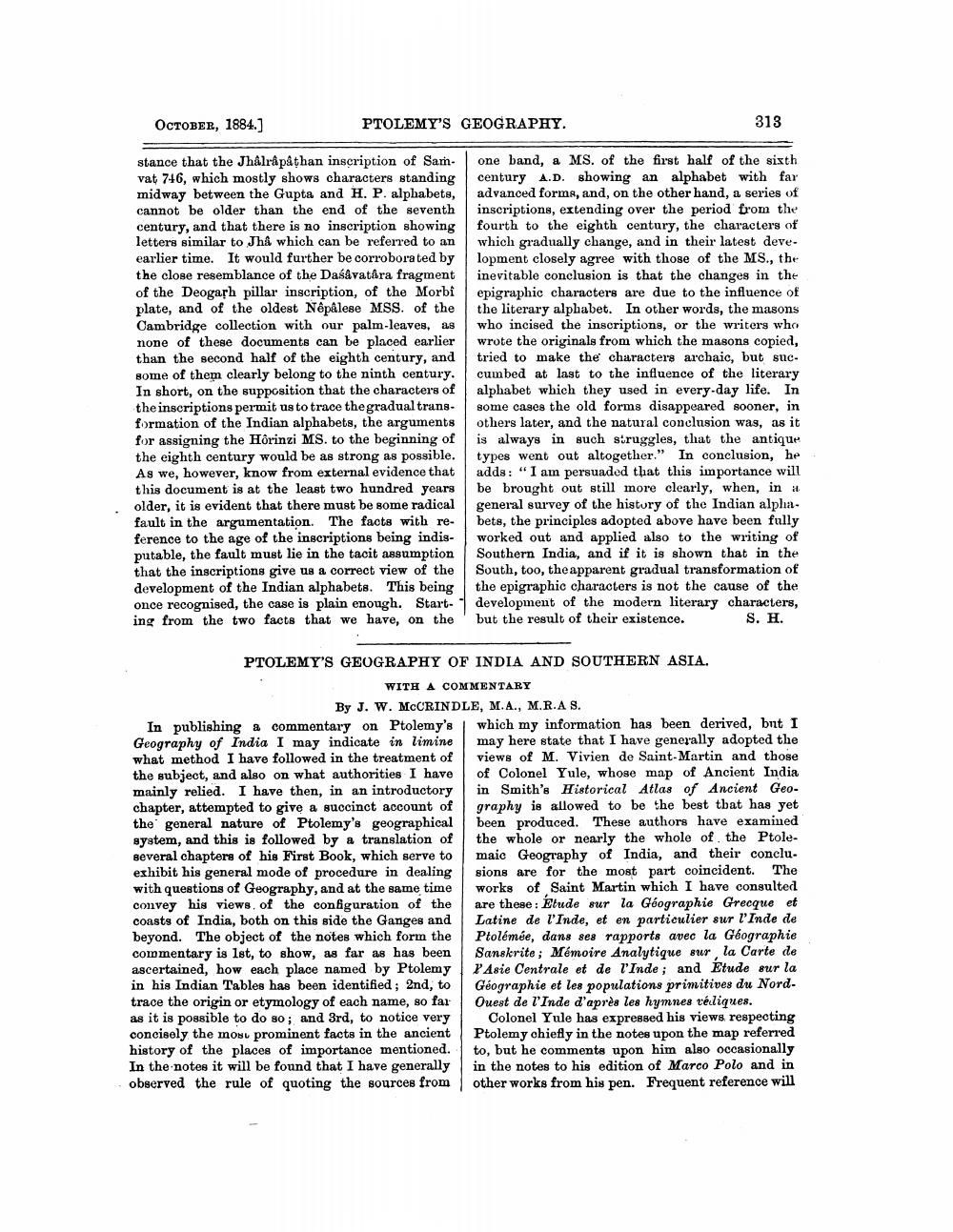________________
OCTOBER, 1884.)
PTOLEMY'S GEOGRAPHY.
313
stance that the Jhålrå påthan inscription of Sam. one band, a MS. of the first half of the sixth vat 746, which mostly shows characters standing century A.D. showing an alphabet with fax midway between the Gupta and H. P. alphabets, advanced forms, and, on the other hand, a series of cannot be older than the end of the seventh inscriptions, extending over the period from the century, and that there is no inscription showing fourth to the eighth century, the characters of letters similar to Jhå which can be referred to an which gradually change, and in their latest deve. earlier time. It would further be corroborated by lopment closely agree with those of the MS., the the close resemblance of the Daśávatára fragment inevitable conclusion is that the changes in the of the Deogarh pillar inscription, of the Morbi epigraphic characters are due to the influence of plate, and of the oldest Nepalese MSS. of the the literary alphabet. In other words, the masons Cambridge collection with our palm-leaves, as who incised the inscriptions, or the writers who none of these documents can be placed earlier wrote the originals from which the masons copied, than the second half of the eighth century, and tried to make the characters archaic, but suc. some of them clearly belong to the ninth century. cumbed at last to the influence of the literary In short, on the supposition that the characters of alphabet which they used in every day life. In the inscriptions permit us to trace the gradualtrans. some cases the old forms disappeared sooner, in formation of the Indian alphabets, the arguments others later, and the natural conclusion was, as it for assigning the Hôrinzi MS. to the beginning of is always in such struggles, that the antique the eighth century would be as strong as possible. types went out altogether." In conclusion, he As we, however, know from external evidence that adds: "I am persuaded that this importance will this document is at the least two hundred years be brought out still more clearly, when, in a older, it is evident that there must be some radical general survey of the history of the Indian alphafault in the argumentation. The facts with re- bets, the principles adopted above have been fully ference to the age of the inscriptions being indis- worked out and applied also to the writing of putable, the fault must lie in the tacit assumption Southern India, and if it is shown that in the that the inscriptions give us a correct view of the South, too, the apparent gradual transformation of development of the Indian alphabets. This being the epigraphic characters is not the cause of the once recognised, the case is plain enough. Start- development of the modern literary characters, ing from the two facts that we have, on the ' but the result of their existence. S. H.
PTOLEMY'S GEOGRAPHY OF INDIA AND SOUTHERN ASIA.
WITH A COMMENTARY
By J. W. MCCRINDLE, M.A., M.R.AS. In publishing a commentary on Ptolemy's which my information has been derived, but I Geography of India I may indicate in limine may here state that I have generally adopted the what method I have followed in the treatment of views of M. Vivien de Saint-Martin and those the subject, and also on what authorities I have of Colonel Yule, whose map of Ancient India mainly relied. I have then, in an introductory in Smith's Historical Atlas of Ancient Geochapter, attempted to give a succinct account of graphy is allowed to be the best that has yet the general nature of Ptolemy's geographical been produced. These authors have examined system, and this is followed by a translation of the whole or nearly the whole of the PtoleBeveral chapters of his First Book, which serve to maio Geography of India, and their conclu. exhibit his general mode of procedure in dealing sions are for the most part coincident. The with questions of Geography, and at the same time works of Saint Martin which I have consulted convey his views of the configuration of the are these: Etude sur la Géographie Grecque et coasts of India, both on this side the Ganges and Latine de l'Inde, et en particulier sur l'Inde de beyond. The object of the notes which form the Ptolémée, dans ses rapports avec la Géographie commentary is 1st, to show, as far as has been Sanslerite; Mémoire Analytique sur la Carte de ascertained, how each place named by Ptolemy PAsie Centrale et de l'Inde; and Etude sur la in his Indian Tables has been identified; 2nd, to Géographie et les populations primitives du Nordtrace the origin or etymology of each name, so far Ouest de l'Inde d'après les hymnes véliques. as it is possible to do so; and 3rd, to notice very Colonel Yule has expressed his views respecting concisely the mos prominent facts in the ancient Ptolemy chiefly in the notes upon the map referred history of the places of importance mentioned. to, but he comments upon him also occasionally In the notes it will be found that I have generally in the notes to his edition of Marco Polo and in observed the rule of quoting the sources from other works from his pen. Frequent reference will




